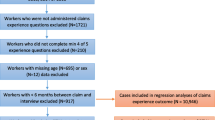Abstract
The cost of providing care that is effective to return injured workers to the workplace has risen in recent years in a manner that appears to be out of control in the workers' compensation system. In turn, medical care costs are an important component of the rapidly increasing costs of workers' compensation insurance. A model of health care delivery that emphasizes early intervention and return to work is presented. This model focuses on providing aggressive treatment of injuries that historically have been reported to be extraordinarily expensive. This paper is a case study of a managed care treatment model and presents costs of treatment in the first year of utilization. Medical care costs of 295 cases are compared with state and national figures and are found to be substantially better, especially with regard to soft tissue injuries and injuries that involve days lost from work.
Similar content being viewed by others
References
Department of Commerce Bureau of the Census. Statistical Abstract of the United States: 1993 (113th Ed.). Table 599, Washington, DC, 1993, p. 379.
Webster BS, Snook SH. The cost of 1989 Workers' Compensation low back pain claims. Spine 1994; 19(10): 1111–1116.
National Council on Compensation Insurance. Media Release. National Safety Council Research & Statistical Services: 1–4, Itasca, IL, 1993.
Kovar MG, LaCroix AZ. Aging in the Eighties, Ability to Perform Work-Related Activities, Data from the Supplement on Aging to the National Health Interview Survey, United States, 1984. Advance Data from 14tal and Health Statistics, No. 136, DHHS Pub. No. (PHS) 87-1250, Public Health Service, National Center for Health Statistics, Hyattsville, MD, May 8, 1987.
Pope MH, Frymoyer JW, Andersson, G, eds. Occupational low backpain. New York: Praeger, 1984.
Deyo RA, Bass JE. Lifestyle and low-back pain: The influence of smoking and obesity. Spine 1989; 14(5): 501–506.
Antonakes JA. Claims costs of back pain. Best's Review. September 1981.
Leavitt SS, Johnston TL, Beyer RD. The process of recovery: Patterns in industrial back injury. Part I: Costs and other quantitative measures of effort. Indust Med Surg 1971; 40(8): 7–14.
Klein BP, Jensen RC, Sanderson LM. Assessment of workers' compensation claims for back strains/sprains. J Occup Med 1984; 26: 443–448.
Spengler DM, Bigos SJ, Martin NA, Zeh J, Fisher L, Nachemson A. Back injuries in industry: A retrospective study. I. Overview and cost analysis. Spine 1986; 11(3): 241–245.
Snook SH, Wébster BS. The cost of disability. Clin Orthop Rel Res 1987; 221: 77–84.
Jette AM, Smith K, Haley SM, Davis KD. Physical therapy episodes of care for patients with low back pain. Phys Ther 1994; 74(2): 101–115.
California Workers' Compensation Institute Bulletin (92-16), September 14, 1992.
Swedlow A, Johnson G, Smithline N, Milstein A. Increased costs and rates of use in the California Workers' Compensation System as a result of self-referral by physicians. N Engl J Med 1992; 327(21): 1502–1506.
Gervais S, Dupuis G, Veronnean F, Bergeron Y, Millette D, Avard J. Predictive model to determine cost/benefit of early detection and intervention in occupational low back pain. J Occup Rehab 1991; 1(2): 113–131.
Moffroid MT, Aja D, Haugh LD, Henry S. Efficacy of a part-time work hardening program for persons with low-back pain. Work Summer 1993; 3(3): 14–20.
National Council on Compensation Insurance. Workers' Compensation Claim Characteristics, 1991.
Wheaton C. Crawford results vs NCCI results in workers' compensation: A study in benchmarking. Crawford Risk Rev 1993; 9(4): 2–9.
California Workers' Compensation Institute. Workers' compensation litigation costs, 1990, CWCI Research Notes, September 1991.
California Workers' Compensation Institute Bulletin (93-8). May 14, 1993.
California Workers' Compensation Institute Bulletin (93-9). May 21, 1993.
California Workers' Compensation Institute Bulletin (93-17). December 7, 1993.
California Workers' Compensation Institute Bulletin (93-18). December 13, 1993.
Scofea LA. The development and growth of employer-provided health insurance. Monthly Labor Rev 1994; 117(3): 3–10.
Lamb E. Growth rate slows down in consumer prices, 1994. Monthly Labor Rev May 1994; 5.
Spitzer WO, LeBlanc FE, Depuis M. Scientific approach to the assessment and management of activity-related spinal disorders. Spine 1987; 12(7S).
Wood GA, Morrison DL, Macdonald S. Factors influencing the cost of workers' compensation claims: The effects of settlement method, injury characteristics, and demographics. J Occup Rehab 1993; 3(4): 201–211.
Author information
Authors and Affiliations
Rights and permissions
About this article
Cite this article
Matheson, L.N., Brophy, R.G., Vaughan, K.D. et al. Workers' compensation managed care: Preliminary findings. J Occup Rehab 5, 27–36 (1995). https://doi.org/10.1007/BF02117818
Published:
Issue Date:
DOI: https://doi.org/10.1007/BF02117818



